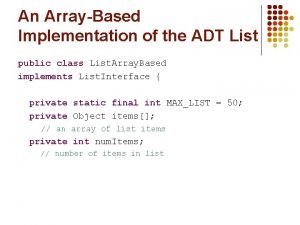SLL Implementation ADT LISTS Singly Linked Lists One










- Slides: 10

SLL Implementation ADT: LISTS

Singly Linked Lists: • One implementation of ADT List • NOT sequential in memory • Consists of a bunch of nodes. • Each node holds the address of the next node • So the first node has no idea where the 4 th node is in memory • Only the third node knows where the 4 th node is • The list must have the address of the first node stored somewhere • (because that’s how we find the address of the second node, • Which is how we find the address of the third node • Etc.

Linked List constructor: • Start with a Null list • First pointer must point to NULL • Last pointer must point to NULL • Size must be set to 0 SLL: : SLL(){ first = NULL; last = NULL; size = 0; } How would you add a first node? � When we first instantiate a linked lists, there are no nodes. Since there are no nodes, we want to initialize the first and last pointer to NULL and the size to 0 You could also have a second constructor: � The constructor creates (using new) a node � makes that be the first, last (and only) node in the list � set the size to 1 � It would look almost exactly the same as add. First (next slide)

Add first node to list? Code: void SLL: : add. First(int x) { first = new SNode (x); // makes a new node, //then sets first to point to the new node last = first; // there’s only one node – last and //first point to the same node size++; // the linked list’s size goes up by one • Create a brand new node (this is just creating a node): • Snode *n = new Snode (x) //where x is the data part of the node (assume x is 3) • Set the first pointer to point to the new node • Set the last pointer to point to the new node • Increase the size of the list by one 3 //cout << " added first "; NULL } first last • How would you add to the end of the list?

Add to the end of the list? push(int x) Code: void SLL: : push(int x) { Snode *n = new SNode (x); last->next = n; // makes the old //last’s next point to //the new node n last = n; // makes last point to the //new last (n) size += 1; // list size grew by one } • Create a new node: • Snode *n = new Snode (x) //x is data for new node • Set the last node in the list’s next pointer to the new node • last->next = n • Set the last pointer to point to the new node • last = n; • Increase the size of the list by one • size += 1

Push (adding) • Time analysis: • We have a pointer (the address of) the last node in the list. So: • • 1 step: create a new node 1 step make the last node point to the new node 1 step: make the new node be the last node 1 step: change the size • 4 steps total. We drop constants. • O(1)!!! • THIS IS BETTER THAN ARRAYS!!!

print. SLL() : O(n) void SLL: : print. SLL() { SNode *tmp = first; while (tmp != NULL) { cout << tmp->data << “, ”; tmp = tmp->next; } cout << endl; } Remember: what connects each node to the next node is the *next pointer! 1. Make a tmp variable – holds the address of a node 2. Have the tmp variable hold the address of the first node 3. Loop: 1. Print out the data in a node. 2. Makethe tmp variable hold the address of the next node in the list 1. tmp = tmp->next: • Tmp holds an address of a node • In each node the next field holds the address of the next node. 4. Also known as making the temp pointer point to the next node in the list Continue until you hit the end of the list continue until the temp pointer is actually NULL 1. • This changes the address in tmp to hold the address of the next node First 3 7 4 2 NULL Last

add. At. K(x, k) void SLL: : add. At. K(int x, int k){ // TRICK TO ALL LINKED LISTS: DON’T LOSE TRACK OF ANY ADDRESSES SNode *tmp = first; if (k==0) { add. At. Front(x); size++; } if (k < size && k >= 0) { for (int i = 0; i < k-1; i++) { //going to the node BEFORE where we want to insert tmp = tmp->next; // what type is the next field? ALWAYS keep this in mind… } SNode *tmp 2 = tmp->next; //temp pointer holds address of next node in the list (so I don’t lose it) tmp->next = new SNode(x); // creating a new node and changing the temp node’s //next address to hold the address of the new node tmp = tmp->next; // make tmp point to (aka hold the address of) the new node tmp->next = tmp 2; // make the new node’s next field hold the address of the old next node (tmp 2) // could have reduced the above two lines to: tmp->next = tmp 2; size++; } } What if we did this with an array?

Concatenate (Join) void SLL: : Concatenate(SLL: list 2){ last->next = list 2 ->first; last = list 2 ->last; size += list 2 ->size; } • Seriously, that’s it! • 3 steps • O(1) Now, think about doing this with an array!

Take-aways! • Singly Linked Lists: • Each node only holds the address of the next node • Don’t lose addresses of nodes! • Remember, often the only thing that holds the address of a node in a list is the next field of the node before it! • To traverse a list: • Have a tmp variable that holds an address of a node • Continuously update the tmp variable to hold the address of the next node • Traversing the list (printlist): O(n) • Can add nodes • Push (at end of list) O(1)!!! • Concatenate: O(1)!!! • Better than arrays!
 In linked list the successive elements
In linked list the successive elements Singly vs doubly linked list
Singly vs doubly linked list Singly vs doubly linked list
Singly vs doubly linked list Single linked list algorithm
Single linked list algorithm Java data structures
Java data structures Polynomial multiplication using linked list in c
Polynomial multiplication using linked list in c Advantages of singly linked list
Advantages of singly linked list Singly linked list
Singly linked list Adt linked list
Adt linked list Array based implementation of list adt
Array based implementation of list adt Single linked list adalah yang paling dari semua varian
Single linked list adalah yang paling dari semua varian



















